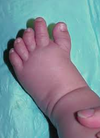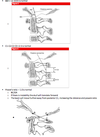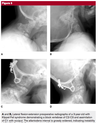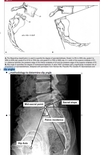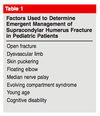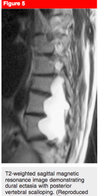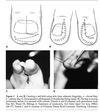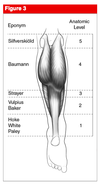Pediatrics Flashcards
What are associated anomalies with this deformity?

Klipell Fiel
congential scoliosis
UE abnormalities
diastomeomyelia
renal disease
What is the classification of spregnel?

What are the procedures for spregnel
Done for stage 3/4 to improve cosmesis and abduction
Between ages 3-8, >8 is not a good candidate
Woodward with clavicular osteotomy is the preferred procedure
Procedure is done prone, tunnel subfacia anterior to do the clavicle

What are risk factors for brachial plexus palsy
large babies
difficult presentation
shoulder dystocia
forceps delivery
breech position
prolonged labor
What are prognostic factors for brachial plexus palsy?
90% will recover without intervention - can occur for up to 2 years
70% of those affected will develop glenoid retroversion
Good - biecps twitch by two months
Bad
lack of biceps function
preganglionic injuries; Horner’s syndrome, loss of rhomboid function
avulsion injuries (worst prognosis)
What is Erb’s palsy?
Mechanism
results from excessive displacement of head to opposite side and depression of shoulder on same side producing traction on plexus
occurs during difficult delivery in infants or fall onto shoulder in adults
Physical exam
clinically, arm will be adducted, internally rotated, at shoulder; pronated, extended at elbow (“waiter’s tip”)
C5 deficiency
axilllary nerve - weakness in deltoid, teres minor
suprascapular nerve - weakness in supraspinatus, infraspinatus
musculocutaneous nerve - weakness to biceps
C6 deficiency
radial nerve - weakness in brachioradialis, supinator
Prognosis - best prognosis

What is klumpke’s palsy?
Mechanism
rare in obstetric palsy
usually avulsion injuries caused by excessive abduction (person falling from height clutching on object to save himself)
other causes may include cervical rib, or lung mets in lower deep cervical lymph nodes
Physical exam
deficit of all of the small muscles of the hand (ulnar and median nerves)
clinically, presents as “claw hand”
wrist held in extreme extension because of the unopposed wrist extensors
hyperextension of MCP due to loss of hand intrinsics
flexion of IP joints due to loss of hand intrinsics
Prognosis
poorer
frequently associated with a preganglion injury and Horner’s Syndrome
Ptosis, myosis, anhydrosis

Draw the brachial plexus

What are indications for microsurgery associated with bracial plexus palsy
complete flail arm or horner’s at one month
Diagnosis? Incidence? Options for treament (general)

Brachial Plexus Palsy - No IR
-
At time of birth
- PT for ROM and monitor
- 90% will improve
-
Early micro surgery (graft or repair)
- fail arm at one month
- horner’s syndrome at one month
- root avulsion (only grafting)
-
contracture release (any age)
- pec, subscap z-lengthening, arthroscopic subscapular release
-
L’Episcopo lat dorsi/teres major transfer with pec major contracture release
- requires a congruent joint
- usually children < 4yo
-
Proximal humerus rotational osteotomy
- incongruent joint
- >5yo

Deformity associated with madelung’s
Volar carpal subluxation
proximal radial synostosis
increased radial inclination
volar tilt
volar-ulnar tethering of vickers ligament
What is vickers ligament
thickening of radiolunate ligament - madelungs
What is leri-wiell
rare genetic disorder caused by mutation in the SHOX gene
SHOX stands for short-statute homeobox-containing gene
anatomically at the tip of the sex chromosome - pseudo-sex linked disorder
causes mesomelic dwarfism (short stature)
Normal intellegene
associated Madelung’s defomity of the forearm
What is the treatment for this deformity

watch if they are young, deformity is small; assess with serial XR
Consider OR for pain or functional deformity
Physiolysis or Vickers release - open physis with progression
Radial ostotomy, vickers release, +/- ulnar ostoetomy, +/- ulnar epiphyseodesis
What is the evidence for screening DDH
No evidence to screen
Imaging prior to 6 months in infants with clinical evidance, fam hx, breech,
What factors are associated with increased incidence of LCP?
Perinatal:
positive family history
low birth weight
abnormal birth presentation
Postnatal:
children exposed to second hand smoke
Ethnics:
Asian, Eskimo and Central European decent
What are the associated conditions of LCP?
ADHD in 33% of cases
What factors are associated with poor prognosis in this patient?

bone > 6 years
female sex
decreased hip range of motion
Lateral pillar, head sphericity
Most patients will do ok until 6th decade

What are the caterall risk factors associated with LCP?
Lady Gaga Met Holy Cow
2 or more/5 confers poor prognosis
Lateral subluxation of the femoral head
Gage sign - V-shaped radiolucency in the lateral portion of the epiphysis and/or adjacent metaphysis
Metaphyseal cyst
Horizontal proximal femoral physis
Calcification lateral to the epiphysis
What are the lateral pillar and stulberg classfications
Lateral pillar (fragmentation phase)
A- none
B - >50% no height loss
B/C - >50% height loss
C - < 50% lateral pillar

What are treatment options for LCP?
Goal : low stulberg classficiation
< 8 = nothing, casting is controversial
> 8, lateral pillar B and B/C in fragmentation phase = femoral osteotomy or pelvic ostetomy containment procedure
C - later treatment
Outcomes you should know for LCP
no positive effect has been found for containment surgery performed after initial or early fragmentation stage
children with lateral pillar A and those with B under 8 years did well regardless of treatment
large recent studies show improved outcomes with surgery for lateral pillar B and B/C in children > 8 years (bone age >6 years)
poor outcome for lateral pillar C regardless of treatment
Risk factors for developing this pathology

males (male to female ratio is 3:2)
African Americans
Pacific islanders
obese children - single greatest risk factor
during period of rapid growth
bilateral in 20% (20-40% May go on to develop bilateral)
When would you consider endocrine WU for SCFE and what are you looking for?
child is < 10 years old
weight is < 50th percentile
- *hypothyroidism** (labs show elevated TSH)
- *renal osteodystrophy** (abnormal BUN and creatinine)
- *growth hormone treatment**
What is the risk of AVN associated with the loder classification?
stable - AVN = 10%
able to bear weight with or without crutches
unstable - AVN = 47%
unable to ambulate (not even with crutches)
Chondrolysis after SCFE is associated with
unrecognized implant penetration of the articular surface
spica cast immobilization
Advanced SCFE
Intertrochanteric osteotomy
AVN following SCFE is associated with
unstable slip (47%)
hardware placement in posteriosuperior femoral neck
Increased number of pins
Cuneiform osteotomy
What are options for late deformity in SCFE
arthroscopic vs mini anterior for osteochondroplasty
surgical dislocation for more severe deformity
Southwick osteotomy
Differential? Indications for surgery?

-
Differential for aquired coxa vara
- AVN: (DDH or Perthes)
- Fibrous Dysplasia
- SCFE
- Rickets
- Osteomyelitis of Hip and Septic Arthritis
- traumatic
- Paget’s Disease
-
Imaging/Indications for valgus osteotomy
- Hilgenreiners angle < 45 - nonop
- Hilgenreiners angle > 60
- neck shaft angle < 110
-
Considerations with osteotomy
- might need to tension abductors
- may have LLD
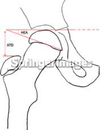
thought to be a cause of sacral agenesis
maternal diabetes
associations with sacral agenesis
gastrointestinal disorders (imperforate anus)
genitourinary disorders
cardiovascular disorders
lower extremity deformities
progressive kyphosis
what are the clinic findings associated with sacral agenesis
prominent lower lumbar spine
extended knees, flexed hips, and equinovarus feet.
classic sign of buttock dimping
What are leg abnormalities associated with PFFD
orthopaedic manifestations
fibular hemimelia (50%)
ACL deficiency
PCL deficiency
Hypoplastic lateral condyle = genu valgum
coxa vara
knee contractures
Hypoplastic or dislocated patella
nonorthopaedic manifestations
dysmorphic facies found in rare autosomal dominant type
What is the Aitken classficiation for PFFD
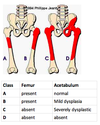
What are treatment options for PFFD
-
limb lengthening with or without contralateral epiphysiodesis
-
indications
- predicated limb length discrepancy of <20 cm at maturity
- stable hip and functional foot
- femoral length >50% of opposite side
- femoral head present (Aiken classifications A & B)
-
contraindications
- unaddressed varus, proximal pseudoarthrosis, or acetabular dysplasia
- can do a containment procedure in A/B
- unaddressed varus, proximal pseudoarthrosis, or acetabular dysplasia
-
indications
-
knee arthrodesis with foot ablation
-
indications
- ipsilateral foot is at the level of contralateral knee or more proximal
- prosthetic knee will not be below the level of the contralateral knee at maturity
- need for improved prosthetic fit, function, and appearance
-
indications
-
femoral-pelvic fusion
-
indications
- femoral head absent (Aiken classifications C & D)
-
Fusion
- fuse the femur to the acetabulum with the femur at 90 degrees
- knee flexion and extension becomes hip motion
-
Brown’s procedure
- __180 degree rotation so the knee becomes the hip and the ankle becomes the knee
- function as a BKA
-
indications
-
Van Ness rotationplasty
-
indications
- ipsilateral foot at level of contralateral knee
- ankle with >60% of motion
- absent femoral head (Aiken classifications C & D)
-
surgical technique
- 180 degree rotational turn through the femur
- ankle dorsiflexion becomes knee flexion
- allows the use of a below-knee prosthesis to improve gait and efficiency
-
indications
-
amputation
-
indications
- femoral length <50% of opposite side
-
surgical technique
- preserve as much length as possible
- amputate through the joint, if possible, in order to avoid overgrowth which can lead to difficult prosthesis fitting
- fit for prosthesis at 6 months for UE and 1 yr for LE
-
indications
What are the goals of pediatric amputation?
(1) Preserve length.
(2) Preserve important growth plates.
(3) Per- form disarticulation, rather than transosseous amputation, whenev- er possible.
(4) Preserve the knee joint whenever possible.
(5) Sta- bilize and normalize the proximal portion of the limb.
(6) Be pre- pared to deal with other issues in addition to limb deficiency.
What is commonly associated with limb hemihypertrophy and what exam do you need to perform?
Wilm’s tumour
serial US until age 5
What are the growth rates of the lower limb?
proximal femur - 3 mm / yr (1/8 in)
distal femur - 9 mm / yr (3/8 in)
proximal tibia - 6 mm / yr (1/4 in)
distal tibia - 5 mm / yr (3/16 in)
What are four ways to assess projected limb length
Green-Anderson tables
uses extremity length for a given age
Moseley straight line graph
improves on Green-Anderson method by reformatting data in a graph form
accounts for differences between skeletal and chronologic age
minimizes error
averages serial measurements
Multiplier method
prediction based on multiplying the current discrepancy by a sex and age specific factor
most accurate for congenital LLD
1/2 of final leg length
girls at age 3
boys at age 4
What is the most accurate way to predict LLD in congential differences
mutiplier
What are the options for LLD
Shoe lift
< 2 cm
shortening of long side - epiphysiodesis
2-5 cm projected LLD
limb lengthening of short side
> 5 cm projected LLD
lengthening often combined with a shortening procedure (epiphysiodesis, ostectomy) on long side
physeal bar excision
indications
bony bridge involves <50% of physis
at least 2 years left of growth
What are the principles of lengthening
initiation
perform osteotomy at CORA and place fixator
metaphyseal corticotomy to preserve medullary canal and blood supply (too low = risk of nonunion)
distraction
wait 5-7 days then begin distraction
distract ~ 1 mm/day
following distraction keep fixator on for as many days as you lengthened
concurrent procedures
some ream over a nail so ex-fix can be removed sooner
But can put them at risk of infection
lengthening often combined with a shortening procedure (epiphysiodesis, ostectomy) on long side
Complications
Incomplete arrest/ angular deformity
Pin site infections
Fracture
Delayed union
Premature cessation of lengthening
Joint subluxation/dislocation
What are the indications for genetic testing or syndromal work-up in PFFD
usually occurs in isolation
Do work-up if other associated deficiencies
What is the most accurate way to measure LLD
CT scanogram - more accurate in the setting of contractures
What are the non-operative treatment options for LLD
<2cm no treatment
2-5 - shoe lift
>20cm requires extension prosthesis
What are the structural components of congential knee dilocation?
quadricep tendon contracture (short, fibrosis)
anterior subluxation of hamstring tendon
absent suprapatellar pouch
tight collateral ligament
patella laterally dislocated

What syndromes and conditions often occur with congenital knee dislocation?
Syndromes
myelomeningocele
arthrogryposis
Larsen’s syndrome
Conditions
DDH
clubfoot
Metatarsus adductus
congential vertical talus
What is the treatment of congential knee dislocation?
Close reduction, long leg cast - usually in patients with subluxation and most will respond to serial casting to correct hyperextension
Takes presedence over DDH and foot deformity
What are the operative indications for congential knee dislocation?
usually severe dislocation with associated neuromuscular condition
indications
if failure to gain 30 degrees of flexion after 3 months of casting
Or if the knee is not reducible with closed reduction
goal of surgery is to obtain 90 degrees of flexion with
quadriceps tendon lengthening (V-Y quadricepsplasty or Z lengthening) - always
anterior joint capsule release
hamstring tendon posterior transposition
collateral ligaments mobilization
postoperative
cast in 45 to 60 degrees of flexion for 3 to 4 weeks
Where is a pediatric popliteal cyst located? How is it different from an adult and what is the treament
semimembranosus
medial head of gastrocnemius
Not associated with medial meniscal tear
Usually resovles without surgery
What is the differential for genu valgum
bilateral genu valgum
physiologic renal osteodystrophy (renal rickets)
Because it usually presents when the child is skeletally in valgus, the weakness tends to accentuate this deformity
skeletal dysplasia
Morquio syndrome
spondyloepiphyseal dysplasia
chondroctodermal dysplasia
unilateral genu valgum
physeal injury from trauma, infection, or vascular insult
proximal metaphyseal tibia fracture (Cozen’s fracture)
Will see evidence of physeal dysplasia or assymetric growth lines
benign tumors
fibrous dysplasia
osteochondromas
Ollier’s disease
What are the deformities associated with blounts and what are the radiographic features?
genu varum
flexion, Internal tibial torsion
Radiographic findings
varus focused at proximal tibia
severe deformity
asymmetric bowing
progressing deformity
sharp angular deformity
lateral thrust during gait
metaphyseal beaking
What are two pertinant radiographic measurements to help quantify blounts
metaphyseal-diaphyseal angle (Drennan)
angle between line connecting metaphyseal beaks and a line perpendicular to the longitudinal axis of the tibia
>16 ° is considered abnormal and has a 95% chance of progression
<10 ° has a 95% chance of natural resolution of the bowing
tibiofemoral angle
angle between the longitudinal axis of the femur and tibia
What is your differential for genu varum
blounts
osteogenesis imperfecta
osteochondromas
trauma
various dysplasia
Bilateral
Rickets - osteopenia and widened physes
Skeletal dysplasia

What are the options for treatment of blounts
KAFO
indications
Stages I and II in children < 3 years (especially if unilateral)
bracing must continue for approximately 2 years for resolution of bony changes
Outcomes
Improved if unilateral
Poor results - bilateral, obese
Improvement should occur with-in one year
Proximal valgus osteotomy or growth modulation
children > 3 years
risk of recurrence is significantly lessened if performed before 4 years of age
stages V and VI
failure of brace treatment
***Make sure you overcorrect by 10 deg if doing an osteotomy
Risk factors for Blounts
A disease with medial physeal interuption, with progression to fibrous tissue and eventually physeal bar
Obesity
Hispanic/Black
Vit D
Early walking
What are you considerations in the treatment of infantile blounts?
Valgus/flexion/IR - proximal tibial osteotomy
Progression - will often need further sx
Growth moduation - lateral hemiephyseodesis
LLD - unilateral disease
Joint line - medial plateau elevation
Compartment syndrome - anterior fasciotomy
Bar resection - with PMMA or fat, for more severe disease
What are the radiographic findings of adolesenct blount
narrowing of the tibial epiphysis
widening of the medial tibial growth plate
occasional widening of the lateral distal femoral physis
metaphyseal beaking less commonly seen with adolescent Blount’s
How is adolesenct blount different from infantile?
Infantile - bilateral, severe, usually will progress (overcorrect osteotomy by 10-15 deg), < 3 can be treated with KAFO
Adolesenct - unilateral, no progression (do not overcorrect osteotomy), femoral valgus will not resolve,
Treatment options for adolescent blounts
-
lateral tibia and fibular epiphysiodesis
- indications
- mild to moderate deformity with growth remaining
- outcomes
- up to 25% may require formal osteotomy due to residual deformity
- indications
-
proximal tibia/fibula osteotomy
- indications
- more severe cases in the skeletally mature
- No overcorrection
- There should be no further progression of the deformity
- outcomes
- multiplanar external fixation following osteotomy allows gradual angle and length correction and decreases risk on neurovascular structures
- Will usually appear valgus due to big thighs, patient should be warned that their alignment is normal
- indications
-
distal femoral osteotomy or epiphysiodesis
- indications
- for distal femoral varus deformity of 8 degrees or greater
- Should be done at the same time at the tibia
- Will not resolve as it will in infantile blounts
- indications
What is the diganosis of normal genu valgum
between 3-4 years - 20 degrees
after age 7 valgus - 12 degrees
after age 7 the intermalleolar distance should be <8 cm
What are the indications for observation of genu valgum
genu valgum <15 degrees in a child <6 years of age
(there is no role for bracing a pathological deformity because it will often progress, a physiological deformity will correct on it’s own; only blount’s is an acception to this)
What are your indications and options for surgery for genu valgum
- <10 yo
- > 15-20° of valgus
- >10 yo
- if line drawn from center of femoral head to center of ankle falls in lateral quadrant of tibial plateau
- Options
- Hemiepiphyseodesis/tethering - guided growth
- osteotomy (no growth remaining)
- TSF if need combined angular and lengthening > 10% of bone
What is the epidemiology of pseudosubluxation of the spine
demographics
seen in children less than 8 years
location
C2 on C3 is most common
C3 on C4 is second most common
Pathophysiology
caused by the horizontal nature of the facet joints at younger ages
facet joints become more vertical with age
What is a radiographic determinant of pseudosubluxation
Swischucks line
spinolaminar line drawn from spinolaminar point on C1 to C3
spinolaminar point on C2 should be within 1.5 mm of spinolaminar line
helpful to differentiate pseudosubluxation from true injury

What factors support pseudosubluxation
reduction of subluxation with neck extension
spinolaminar line within 1.5mm of C2
no history or physical findings of significant trauma
absence of anterior soft-tissue swelling
What are common causes of atlantoaxial rotatory displacement
**trauma retropharyngeal irritation (Grisel's disease)**
other less common causes include
Down’s syndrome
rheumatoid arthritis
tumours
congenital anomalies
What is the best way to diagnose antlantoaxial rotatory subluxation
Dynamic CT gold standard - rotational alignment won’t change
What is the treatment for atlantoaxial rotatory instability
Nonoperative
soft collar, anti-inflammatory medications, exercise program
indications
subluxation present for < 1 week (traumatic or Grisel’s disease)
many patients probably reduce spontaneously before seeking medical attention
head halter traction and bracing
indications
subluxation persists > 1 week
technique
small amount (5 lbs.) usually enough
either in hospital or at home
muscle relaxants and analgesics may be needed
halo traction and bracing
indications
subluxation persists > 1 mos.
posterior C1-C2 fusion
indications
subluxation persists > 3 mos (or late diagnosis)
neurologic deficits present
What are the pros and cons for a medial approach for DDH? What are the intervals
-
Approach
- supine, flexed, abducted, ER
- incision along adductor longus 3cm from the pubic tubercle
- gracilis, adductor longus
- adductor brevis, adductor magnus
- protect the posterior division of the obturator nerve
- Protect the medial circumflex artery, release the psoas
-
Pros
- directly addresses block to reduction
- can be used in patients under 12 months of age
- less blood loss with less soft tissue dissection
- less scar formation for future surgery
-
Cons
- unable to perform a capsulorrhaphy
- higher association of AVN due to disruption of the medial circumflex artery
What are the recent AAOS recommendations for DDH
No evdience for screening
Should get imaging < 6 months if family history, breech, clinical evidence
No need for U/S , 6 weeks
No need to re-examine a hip that was normal at initial imaging
No support for bracing an unstable hip with normal radiological markers
No evidence to show whether limited or delayed bracing is better
No evidence which brace works better
No evidence to monitor hip
How long should you treat a child in a pavlik?
Age at diagnosis plus 3 months
What are blocks to open reduction for DDH
Extra-articular
iliopsoas contracture - constricts anterior capsule
Adductor contracture
Adductor tenotomy can improve abduction to maintain reduction
capsular constriction - hourglass contracture
Intra-articular
inverted labrum
Pulvinar
hypertrophied ligamentum teres
**Neo-limbus forms around the false acetabulum, it is not recommended to resect this
What position do you put a hip spica on for DDH? What is your desired safe zone?
flexion of 100 deg.
abduction of 45 deg
neutral rotation
3 months
‘human position’
change cast at 6 weeks for hygiene
Physical exam and radiology for DDH
-
Physical
- Overall assessment, assess for torticollis, spina bifida, clubfoot, MA, other dislocations or contractures, LLD
- LLD, thigh assymetry
- barlow, ortelani (cannot use after 3 months)
- ROM - limited abduction
- trendeleburg, prominent GT, line from GT to umbelicus < 45
-
Ultrasound
- > 6weeks of age, < 6 month
- alpha angle > 60
- > 50% coverage
- assess psoas, capusule, boney acetaulum
- look for subluxation of the femoral head
-
Radiography
- Hilginreiners line, perkins line, shentons line
- AI - <25 deg over 6 months
- development of teardrop is a good sign for reduction
How can you assess if the hip has been reduction for closed reduction in DDH
- Arthrogram
- <5mm dye pool on AP
- psoas over the capsule will create the hourglass
- Safe zone
- > 60 deg = increased risk of AVN
- adductor and psoas release
What is the normal alignment of the knee?
Mechanical axis = 87 deg (knee is in 3 deg of valgus)
LDFA (lateral distal femoral angle) = 84 deg (accounting for 6 deg of valgus of the femur)
Medial proximal tibia angle = 87 deg (accounting for 3 deg of varus)
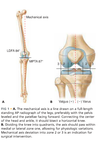
What are special considerations for syndromal kids or kids with poor mobility (MD, CP)
Try to do multi-level surgery at one sitting
Trauma/fixation should allow them to WB immediately or they will never walk again
Options for tethering the physis in growth modulation
Screws across physis (? Reversisble)
Pheimster bone block
Drilling
Staples - reversible
8 plates - reversible
What are important considerations for angular deformity or LLD
Age, amount of growth left
Projected growth discrepancy
Rotational profile, angular deformity
Multilevel surgery should be done at one sitting
(Especially in kids with syndromes and slow mobility because they won’t be able to rehab several surgeries)
Weight bearing
(Consider that in some kids with poor mobility, you need to use a strong construct because they won’t be able to rehab a long deficit from weight bearing)
**Can address angular deformity with modulated growth and then address LLD at maturity - this is an alternative to doing a TSF - Then decide based on LLD
Especially with a valgus knee you need to consider the peroneal nerve
What are common complications when treating angular deformity
peroneal nerve injury (valgus knee)
Prevention
perform a peroneal nerve release prior to surgery
gradually correct the deformity if there is a large defomity
utilize a closing wedge technique
- *Hardware failure** - staples
- *Overcorrection** - monitor every 3 months
What are the diagnostic criteria for NF1

What are the genetics of NF1
- 50% are spontaneous
- autosomal dominant (AD)
- mutation in NF1 gene on chromosome 17q21
- codes for neurofibromin protein
- negatively regulates Ras signaling pathway
- neurofibromin deficiency leads to increased Ras activity
- affects Ras-dependent MAPK activity which is essential for osteoclast function and survival
- neurofibromatosis is the most common genetic disorder caused by a new mutation of a single gene
What are the associated deformities with NF1
extremity deformities
congenital anterolateral bowing and pseudoarthrosis of tibia/ fibula and forearm
hemihypertrophy
spine involvement
scoliosis & kyphosis (dystropic and nondystropic)
atlantoaxial instability
What is your management plan for scoliosis in NF1
screen early
non-dystrophic can become dystrophic
MRI and CT to assess dystrophic featrures, soft tissue mass, neuroma that can make approach difficult
nondystrophic treated as AIS
What are the classes of NF
NF1 (von Recklinghaussen disease)
most common
NF2
associated with bilateral vestibular schwannomas
not associated with scoliosis
Segmental NF
features of NF1 but involving a single body segment
Non-orthopedic manifestations of NF1 (other than ocular and neoplasias)
- Developmental delay - most common genetic disease to cause learning disorder
- Gross motor, speech, hearing can all be affected
- Unidentified bright objects on MRI in brain with unknown clinical significance
- Increased risk for
- Stroke
- Hypertension
- Heart disease
- vasculopathy
What are the common syndromes of dural ectasia
marfan
ehuler danlos
NF1
ank spond
What are the findings associated with dystropic spine in NF1

What is your approach to scolisosis in NF1
Screen early
MRI and CT to rule out dystropic
monitor every 6 months - can progress to dystrophic
non-dystropic can be treated like AIS
What is your approach to a dystropic curve in NF1
a dystrophic curve will progress more rapidly when there are > 3 features
indications
dystrophic scoliosis
Monitor < 20 every 6 months, then fuse >40
Type 1 - no kyphosis
Type 2 - kyphosis >50
Indications for anterior (combined anterior and posterior fusion is controversial)
>90 deg curve
Rapid progression
>50 deg kyphosis
perform early in young children (< 7 yrs) with dystrophic curves
3 weeks pre-op traction shown to help
screen for cervical instability
use pedical screws, better even with deformation due to poor bone quality
complications
high rate of pseudoarthrosis with PSF alone (40%)
pseudoarthrosis rate still high with ASF&PSF (10%)
some recommend augmenting the PSF with repeat iliac crest bone grafting 6 months after the primary surgery
What is the most common complication when treated a dystrophic spine in NF1
psuedoarthrosis
What percentage of patients with NF1 have anterolateral bowing
50% with anterolateral bowing have NF1
10% of NF1 have anterolateral bowing
What is your differential for tibial bowing
anteromedial
- hemimelia
- loss of lateral rays of the foot
posteromedial
- abnormal intrauterine positioning
- dorsiflexed foot pressed against anterior tibia
- will develop leg length discrepancy
- associated with calcaneovalgus deformity
anterolateral
- NF1
- CPT
What is the pathology associated with CPT and NF1
The pathology for NF1 and CPT are the same - increased fibrous tissue, decreased functional osteoclasts (RAS pathway)
Deficiency of the periosteum to differentiate myofibroblasts and chondrocytes
What is your managment for CPT/NF
worse prognosis associated with age and presence of fracture
Bracing - if no fracture
bone grafting with surgical fixation
in bowing with pseudoarthrosis or fracture - prognosis depends on correction of bowing and stabilization
aggressive nonunion debridement, shortening and compression across nonunion
IM nail vs ex-fix (no plate on pathological bone)
*osteotomize the fibula and fix with a k-wire as well
plan to never take the fixation out
amputation with prosthesis fitting
indications
three failed surgical attempts (or when patient asks for it)
Syme’s often superior to BKA due to atrophic and scarred calf muscle in these patients

What are the indcations for amputaiton in CPT/NF1
X3 attempts or when patient asks for it
>5cm LLD
unacceptable deformity
prolonged hospitalization
What are complications associated with CPT after fixation
refracture
LLD
What are the important concepts when fixing CPT
resection of pseudarthrosis to grossly normal bone
correction of deformity
bone grafting
With BMP-Rh2 (controversial)
Iliac crest graft
stabilization of the remaining segments
IM nail vs ex fix (no plates)
Stabilize the fibula also
if <8 yo or for distal fracutre can use a nail crossing the ankle threw the calc
What is your differential

CPT/NF1
Fibrous dysplasia
OM
Fibrosarcoma
Fibular hemimelia
What is the treatment and expectation of posteromedial bowing of the tib
Intrauterine positioning
often associated with calcvalgus foot
often get LLD later, need to follow and perform epiphyseodesis at appropriate time
What MSK conditions can you get with tibial hemimelia
75%
lobster-claw hand
preaxial polydactyly
ulnar aplasia
What is the most common long bone deficiency
fibular hemimelia (linked to sonic hedge hog gene)

What are conditions associated with fibular hemimelia
- anteromedial tibial bowing
- most common cause is fibular hemimelia
- ankle instability
- secondary to a ball and socket ankle
- equinovalgus foot deformity
- tarsal coalition (50%)
- absent lateral rays
- femoral abnormalities (PFFD, coxa vara)
- cruciate ligament deficiency
- genu valgum
- secondary to lateral femoral condyle hypoplasia
- significant leg length discrepancy
- shortening of femur and/or tibia

What are the key things to look for when assessing tibial hemimelia?
-
Look
- Shortening of the affected limb
- anterolateral bowing of the tibia
- prominent fibula
-
Feel
- flexion contracture
- ability to extend knee
- stability of knee
-
Foot
- rigid equinovarus
What are you options for treatment in tibial hemimelia?
-
knee disarticulation followed by prosthetic fitting
- indications
- complete absence of the tibia
- no active knee extension present (most cases)
- indications
-
tibiofibular synostosis with modified Syme amputation
- indications
- proximal tibia present with intact extensor mechanism and minimal flexion contracture
- indications
-
Syme/Boyd amputation
- indications
- ankle diastasis
- indications
What is the Achterman and Birch classification system for CFD?
congenital fibular deficiency
-
Acherman
- Ia - partial deficiency, short fibula
- Ib - 30-50% absenct, does not support ankle
- II - complete absence
-
Birch
-
type 1 - functional foot (>3 rays)
- A - <6%
- nothing, orthosis
- epiphyseodesis
- B - 6-10%
- lenghening
- epiphyseodesis
- C - 11-30%
- may require more than one lengthening or orthosis
- D - >30% difference
- usually requires amputation
- A - <6%
- Type 2- non-funcational foot (<3rays)
*
-
type 1 - functional foot (>3 rays)

What is your work-up and algorythim for treatment of CFD?
-
Necessary Imaging
-
AP bilateral lower extremities
- look for associated deformities
- CT can help assess LLD
- MRI if there is functional instability
- Echo, renal U/S
-
AP bilateral lower extremities
-
Invovle multi-disciplinary team
- PT, psych, prosthetist
- have the families visit clinics to see both reconstructive and amputation options
- emphasize amputation is not a failed option
-
Principles
- Depends on the functionality of the foot and the LLD
- keep in mind ACL def when treating LLD
- no role for ACL reconstruction
- Not advocated to do tibial osteotomy to correct deformity at the time of amputation
- May need a distal femoral osteotomy later to correct valgus
-
Lengthening
- contralateral epiphyseodesis
- one at 5cm, one at 7cm
- may need a final one
-
Genu Valgum
- <15 deg can do epiphyseodesis alone
- >15 deg might need to do an osteotomy
- need to correct for amputations as well to ensure proper prosthesis fitting
-
Amputation
- Indications
- >30% LLD
- >5cm at birth LLD
- functional UE
- Boyd or Syme
- Done when they start to walk
- Indications

What are the complications associated with each treatment for CFD?
-
Amputation outcomes
- higher satisfaction
- lower readmission
- fewer complications
-
Symes amputation
- Posterior migration of the heel pad
- Reformation of the calcaneus (ie, painful stump)
- Wound infection
- Heel pad slough
- Fitting adjustment problems
-
Boyd amputation (maintains more height)
- Delayed calcaneotibial fusion or nonunion
- Calcaneal migration and malalignment
- Wound infection
-
Limb lengthening
- Pin tract infections
- Peroneal nerve injury Tibial/femoral fractures
- Severe depression
- Nonunion of the osteotomy site Joint stiffness
- Joint subluxation
- Persistent or recurrence of knee and foot deformities
- Residual limb length inequality

What are the two most important factors when considering salvage vs amputation for CFD?
- Functional foot
- LLD <30% at maturity
What is the difference in etiology for tib hemi and fib hemi?
Tibial hemimelia has a known genetic, AD cause where fibular hemimelia is sporatic
What is the normal progression of rotational profile in children?
40 deg fem anteversion at birth, masked by femoral ER at times; internal tibial torsion
tibia externally rotates and becomes normal by age 6
femural anteversion resolves by age 10
What are the 5 components of Staheli’s rotational profile?
-
ER Hip/IR hip
- > 70 IR, <20 ER = fem anteversion
-
thigh-foot-axis (5 IR)
- -10 = internal torsion
- transmalleolar axis (5 IR)
- heel bisector angle
- foot progression angle (-5-20)
What are the common pathology by age for intoeing
0-1 yo - MA
1-3 yo - internal tibial torsion
>3 yo - femoral anteversion
What is the Bleck classification for MA?
- *normal** - heel bisector line through 2nd and 3rd toe webspace
- *mild** - heel bisector line through 3rd toe
- *moderate** - heel bisector through 3rd and 4th toe webspace
- *severe** - heel bisector through 4th and 5th toe webspace

What are the normal rotational profiles?
-
Hip Rotation
- Infants - 30 IR, 70 ER
- 10yo - 50 IR, 45 ER
- at 10yo - IR > 80 with ER < 10 is indication for surgery
-
Tibia
- Infant - IR, resolves by 4yo
- 6yo - ER 10 deg
- at 80yo - ER >40 deg is indicatin for surgery
What is the berg classfication of MA?
Simple - MTA
Complex - MTA, lateral shift of midfoot
Skew foot - MTA, valgus hindfoot
Complex skew foot (serpentine foot) - MTA, lateral shift, valgus hindfoot
What are red flags associated with in-toeing that would make you get further work-up?
pain
limb length discrepancy
progressive deformity
family history positive for rickets/skeletal dysplasias/mucopolysaccharidoses
limb rotational profiles 2 standard deviations outside of normal
What are the indications for treatment of MA?
Flexible deformities that can actively be corrected to midline - No treatment required
Flexible deformities that can passively be corrected to midline - Serial stretching by parents at home
Rigid deformity with medial crease - Serial casting with the goal of obtaining a straight lateral border of foot
- usually will improve in 6-8 weeks of casting
- some will recurr by 2-4 yo

What are the indications for surgery and options for MA?
Indications:
failed non-op
severe deformity and difficulty with shoe-wear
> 5yo
Techniques:
*Soft tissue procedures alone are no longer recommended due to soft tissue necrosis
- *lateral column shortening -** done with cuboid closing wedge ostetomy
- *medial column lengthening -** includes a cuneiform opening wedge osteotomy with medial capsular release and abductor hallucis longus recession (for atavistic first toe)

What is the prognosis of MA?
a benign condition that resolves spontaneously in 90% of cases by age 4
another 5% resolve in the early walking years (age 1-4 years)
What pregnancies are associated with MA?
late pregnancy
first pregnancies
twin pregnancies
oligohydramnios
Key points of metatarsus primus varus
-
Adduction deformity of the great toe characterized by
- deformity at metatarsophalangeal joint
- short thick 1st metatarsal
- firm band-like abductor hallucis muscle
-
Associated conditions
- often associated with polydactyly – duplication of the great toe
- Must be differentiated from metatarsus adductus
- Lateral border of the foot is normal
- More rigid than MA
- Early casting is used, associated with hallux valgus
- Severe deformity is indication for osteotomy

What is the pathogenesis and treatment for skewfoot?
- Poorly understood why this develops
- No good measurement to define skewfoot vs MA
- Surgical treatment is only indicated if function is severely limited
-
opening wedge and closing wedge osteotomies
- indications
- indicated if serpentine deformity is symptomatic and significantly limits function
- operative treatment is difficult and often times deformity is accepted and observed
- indications
-
technique
- calcaneal osteotomy for hindfoot valgus
- possible midfoot osteotomies to correct midfoot and forefoot deformities
- multiple metatarsal osteotomies with forefoot pinning and tarsometatarsal capsular release (Hamen procedure)

What is the indication for a derotational supramalleolar ostoeomty for internal tibial torsion?
>6yo
>10 deg IR
rarely causes issues
will not get worse with growth
What is the prognosis and associated syndromes with external tibial torsion?
Will increase with age and is associated with malalignment and patellofemoral syndrome
-
“miserable malalignment” syndrome
- a condition defined as external tibial torsion with femoral anteversion
- Osgood-Schlatter disease
- osteochondritis dessicans
-
early degenerative joint disease
- an association between external tibial torsion and early degenerative joint disease has been found
-
neuromuscular conditions
- may be found with neuromuscular conditions such as myelodysplasia and polio
What are indications for surgical treatment of external tibial torsion
-
indications
- >8yo
- >40deg (3 SD above the mean)
-
technique
-
supramalleolar osteotomy
- cross pins for young children
- IM nail for skeletally mature
- Fibular osteotomy for more severe deformity
-
supramalleolar osteotomy
What is surgery indicated for femoral anteversion?
-
indications
- < 10° of external rotation on exam in an older child (>8-10 yrs)
- rarely needed - only if there is severe comprimised function - tripping, inefficient gait
- Can lead to inefficient abductor function
-
Derotational femoral osteotomy
- typically performed at the intertrochanteric level
- consider correction of varus if present
- amount correction needed can be calculated by (IR-ER)/2
- can be done prone or supine depending on what other procedures you will also be performing

Differential for cavus foot
-
CNS
- CP
- Frederichs ataxia (often can be first diagnosis)
-
Spinal Cord
- Myelodysplasia, syrinx/synringomyelia (unilateral), tethered cord (unilateral), tumors, GBS
- Polio (more historical)
-
Peripheral neuropathy
- CMT/HSMN - most common cause
- Result of a number of mutations resulting in dymyelination
- Most common is X-linked; Peripheral-myelin-protein 22 (PMP-22)
- CMT/HSMN - most common cause
- Aquired - more common in adults
- Tibial fracture/compartment syndrome, sciatic nerve injection, peroneal neuropathy
- Residual clubfoot
What are the key points in evaluation of a cavus foot

What imaging is required in the diagnosis of cavus foot
-
Plain radiographs
- AP - varus
- Lateral
- meary’s angle = 0
- calcaneal pitch = 30 deg
-
EMG
- concerns of CMT or HSMN
- may also require genetic testing
-
Spine MRI
- unilateral
- progressive deformity

What is the non-surgical treatment of cavus foot
-
Activity adjustments
- A runner with a cavus foot needs longer time to recover from injury and is more at risk of injury
-
Accomodative orthotics with high shoe box for claw toes
- Good running shoes for runners
-
PT
- Quads strengthening
- Can help decrease the load the ankle sees when running
- (2.5X body weight, alleviated by eccentric quads contracure)
-
Baclofen, diazepam, Botulinum toxin
- For neuromuscular/CP
What are considerations for tendon transfer in cavus?
- Transfered tendons lose one grade, need at least grade 4
- should be in straight line of pull
- try to adhere to bone rather than tendon
- fixed deformites should be corrected first
- iatrogenic problems can happen in neuromuscular (ie; CP tib ant transfer; will get a new contracture; better to do a split tendon transfer)
What are associations with clubfoot
hand anomalies
diastrophic dwarfism
arthrogryposis
tibial hemimelia
Myelomeningocele
What are the muscle contractures invovled with clubfoot
midfoot Cavus (tight intrinsics, FHL, FDL) forefoot Adductus (tight tibialis posterior) hindfoot Varus (tight tendoachilles, tibialis posterior) hindfoot Equinus (tight tendoachilles)

what are the boney deformites associated with clubfoot
- talar neck is medially and plantarly deviated
- Some believe that this is the primary deformity as it is the most consistent
- Talus grows medially toward the navicular
- the calcaneus is in varus and rotated medially around talus
- Deltoid, spring ligament and PTT keep calcaneous varus
- Achilles keeps heel in equinus
- the navicular and cuboid are displaced medially
- Cuboid is morphologicall normal, just displaced
- Navicular is tethered by the above as well as the knot of henry, capsule
What are the XR findings associated with clubfoot on the lateral
- talus and calcaneus are parallel; usually talocalcaneal angle is > 35 deg
- dorsiflexion view of turco
- flat talar head
- talocalcaneal angle < 35 deg

What are the deformities on an AP associated with clubfoot?
talocalcaneal angle (Kite's) is \< 20° (normal is 20-40°) talus-first metatarsal angles is negative (normal is 0-20°)

Treatment

CLUBFOOT
-
Month 1-4 - PONSETI CASTING
- Weekly Serial Casting (with knee in 90° of flexion )
-
First correct cavus by aligning 1st MT with remaining metatarsals
- This requires supination of the forefoot, it is pronated; usually take one week
- Then correct adduction and heel varus by rotating calcaneus and forefoot around talus (head of talus acts as fulcrum)
- This needs to be done prior to equinus correction, otherwise the calcaneus will be locked under the talus
- Usually takes 4 weeks; cast application while feeding can distract the infant
-
Achilles tenotomy at week 8 (required in 80%)
- Then correct equinus with TAL (If you don’t wait until the navicular is reduced then you will get a rockerbottom foot)
- Perform when foot is 70° abducted and heel is in valgus
- Ponseti method is complete transverse cut
- Can be done in clinic for a small child, or in the OR for a larger/older baby for better analgesia and better case moulding
- No stiches need, just a light dressing, then the cast is applied
- Cast in maximal dorsiflexion and abduction after TAL, overcorrection will prevent recurrence
- This cast is left on 3-4 weeks, more in a larger child
-
Month 4-8 - Foot abduction orthosis (FAO)
- full time until ~ 1 year of age
- nights only from age 1 to ~4
- With Denis Browne bar in external rotation (_70° in clubfoot and 40° in normal foo_t)
- Fit FAO on day of TAL
- Normal to be irritable when casts come off, important to explain this to parents and emphasize risk of recurrence
-
2-4 years - Anterior tibial tendon transfer
- at 2 yrs of age (10-20% will require)
- 10-20% will need TA transfer with or without repeat TAL for recurrent supination, varus, and/or equinus
- Occurs due to incomplete reduction of navicular, changes tib ant from a dorsiflexor to a supnator
-
4-6 weeks repeat casting
- Keep tib ant under the retinaculum to prevent bowstring
- +/- TAL

Treatment of failed clubfoot
- Re-start casting
-
Indications for surgery
- resistant feet
- rockerbottom from casting
-
Surgical options
-
ST release and tendon transfers
-
Posteromedial release - plantar fascia, PTT lengthening
- Deltoid ligament, spring ligament, knot of henry
- Abductor Hallucis is released to get access to these structures
- Whether to release subtalar or ankle capsule depends on the surgeon
-
Tibialis anterior transfer
- To medial cuneiform (only if ossified)
- For neuromuscular kids should use a split transfer
-
Repeat TAL
- Posterior talo-fib and tib-fib ligaments
- Make sure to do your silverskiold
- dosiflexion osteotomy
-
Posteromedial release - plantar fascia, PTT lengthening
-
Medial opening or lateral closing
- 3-10yo
- first ray or cuniform
-
Triple arthrodesis
- 8-10 yo with refractory
-
Talectomy
- 8-10 with insensate foot
-
ST release and tendon transfers
What are the complications associated with nonoperative or operative clubfeet
-
Complications with nonoperative treatment
-
deformity relapse
- relapse in child < 2 years
- noncompliance with FAO
- Inappropraite technique, missed neurological or paralytic foot
- treat with repeat casting
- relapse in child > 2 years
- treat initially with casting
- consider TA tendon transfer
- consider repeat TAL
- treat initially with casting
- relapse in child < 2 years
-
dynamic supination
- treat with whole anterior tibial tendon transfer
-
deformity relapse
-
Complications with Surgical Treatment
-
residual cavus
- result of placement of navicular in dorsally subluxated position
-
pes planus
- results from overcorrection
- undercorrection
- intoeing gait
-
osteonecrosis of talus
- results from vascular insult to talus resulting in osteonecrosis and collapse
-
dorsal bunion
- caused by dorsiflexed first metatarsal and overactivity of anterior tibialis
-
residual cavus
What are the associations and muscle imbalance of equinovarus
-
Associated syndromes
- cerebral palsy (usually spastic hemiplegia)
- Duchenne muscular dystrophy
- residual clubfoot deformity
- tibial deficiency (hemimelia)
-
Muscle imbalance include spasticity of
- tibialis posterior and/or tibialis anterior
- gastroc-soleus complex
- abscense of ligamentous laxity
What are two ways to assess with TA or TP is overactive in equinovarus
-
gait analysis
- diagnosis made with gait analysis showing
- overactivity of tibialis posterior and/or
- overactivity of tibialis anterior
-
confusion test
- helps to distinguish AT vs PT as the primarily involved muscle
- patient performs active hip flexion against resistance while seated
- in a positive confusion test, the tibialis anterior fires with active hip flexion and is typical in patients with CP
- if the foot supinates with dorsiflexion, tibialis anterior is most likely contributing to the equinovarus deformity
What are the surgical indications for equinovarus
-
TAL with tibialis posterior split transfer to peroneus brevis
- indications
- spastic hemiplegia in patient ages 4 to 7
- flexible equinovarus hindfoot
- tibialis posterior spastic in both stance and swing phase (continous activity)
- technique
- reroute half of tendon dorsally and insert into peroneus brevis
- indications
-
Rancho procedure
- indications
- overactive anterior tibialis
- flexible equinovarus deformity
- technique
- split anterior tibialis transfer to cuboid with TAL and intramuscular lengthening of the posterior tibial tendon
- indications
-
Calcaneal osteotomy
- indications
- is required in a rigid hindfoot varus deformity
- technique
- lateral closing wedge osteotomy to incur valgus to the heel
- indications
What are the conditions and pathology of equinovalgus
-
Common foot deformity seen with
- spastic diplegic and quadriplegic cerebral palsy
- fibular hemimelia
-
Deformity consists of
- midfoot abduction
- heel valgus
- equinus contracture
- typically bilateral
-
Muscle imbalance includes (see overview of foot deformity muscle imbalances)
- spasticity of
- peroneals
- gastoc-soleus complex
- weakness of
- ligamentous laxity
- posterior tibialis
- anterior tibialis
- spasticity of
What are the non-operative options for equinovalgus foot
-
bracing and physical therapy
- indications
- flexible deformities
- technique
- ankle foot orthosis or supramalleolar orthosis
- indications
- botox injections
What are the surgical options for a rigid foot with equinovalgus
-
soft tissue procedures
- TAL
- peroneus brevis lengthening
-
calcaneal osteotomy
- medial slide ostetomy or calcaneal lengthening osteotomy
-
lateral column lengthening procedure
- performed through calcaneus or cuboid
-
Grice procedure
- extra-articular subtalar arthrodesis
- place ICBG in lateral subtalar joint to block valgus
- does not interfer with tarsal bone growth
-
subtalar arthrodesis
- stabalizes subtalar joint in correct alignment without fusion
- implant or spacer is placed laterally in the subtalar joint to prop open
What are the pros and cons of plaster and fiberglass

complications with casting
- Pressure sores
- Compartment syndrome
- Univalve plaster
- 50% release
- Then webril is 20% release
- Bivalve fiberglass
- Univalve plaster
- Atrophy, cartilage degredation, ligament weakness
- Don’t immobilize for too long
- Functional casting when appropraite
- Patients with neuromuscular disease are at increased risk of ostetopenia and atrophy
- Should immobilize them for less time
- Cast saw burn
avoid complications with casting
- Complication prevention
- Plaster application
- Don’t apply fiberglass over curing plaster
- Don’t put plaster on a pillow
- Use recommended water temperature
- fiberglass
- Stretch and relax for fiberglass
- Don’t leave sharp fiberglass edges
- Plaster application
- General
- Don’t go past the MC heads, limits fingers
- Don’t end at the fibula = peroneal nerve
- Use safe position for the hand
- Hip spica
- Don’t put lower limb first and use to traction
- Can cause compartment syndrome and popliteal occulsion
- Cast application
- Appropriate padding
- Too much padding can cause loose cast, skin irritation and loss of reduction
- Cast should look like and oval
- Optimal width:height = 0.7
- Don’t change position of the cast after applied
- Weakens the cast
- Puts pressure in the flexion crease
- Appropriate padding
What imaging do you need for this patient and what are the imporant angles

- WB AP/lateral, oblique, harris (TC)
-
Lateral
- Meary’s angle - 0 deg
- Calcaneal pitch - 20 deg
- rule out tarsal coalition, verticle talus
- assess where break in foot is
-
AP
- Ist MT-talus angle - 20deg
- rule out accessory navicular
-
oblique
- best image to see a Cal-nav coalition

What is the pes acetabulum?
Navicular, spring ligament, anterior facet calcaneus

















